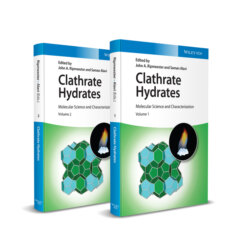Читать книгу Clathrate Hydrates - Группа авторов - Страница 26
2.5 Nikitin and von Stackelberg
ОглавлениеIn the 1930s, B.A. Nikitin [80] prepared mixed hydrates of the noble gases, Xe, Kr, Ar with SO2 by “isomorphous precipitation.” He showed that the noble gases could be separated by partitioning between the solid hydrate and the gas. Of some interest are the claims that he was able to trap neon and radon in SO2 hydrate, the latter to a high degree of enrichment. On the basis of data on mixed radon‐SO2 hydrates, he predicted that the decomposition temperature of radon hydrate at 1 atm would be above 0 °C. He took the noble gas hydrates to be prototypes of a large family of isomorphous hydrates formed by molecules of suitable size and van der Waals character ranging from argon to chloroform. He still held [81] to the general formula for hydrates as given in Bouzat's summary some 15 years earlier, i.e. M·6H2O, but where M could be a gas mixture. Implicit in Nikitin's observations of mixed guests in the hydrates was the solid solution nature of the hydrate, thus also confirming their non‐stoichiometry. However, Nikitin did not comment on any specific features of the hydrate structure [82].
The progression from an essentially molecular picture of hydrates based on Villard's rule, where a guest interacted with an octahedron of water molecules through “sub‐valences,” to an infinite lattice of four‐connected water molecules forming cages, was left to be proposed by Mark von Stackelberg (Figure 2.8). We can speculate that the development of the crystal structure of ice Ih may well have influenced the researchers working on hydrates to also look for ice‐like lattices. Although the first X‐ray structural determinations of Ice Ih took place in 1918 [83], the detailed ice Ih structure was not settled until Pauling's definitive paper appeared in 1935 [84]. This puts knowledge of the ice structure within the timeframe of von Stackelberg's work.
In the late 1930s, von Stackelberg at the University of Bonn initiated his 20‐year research efforts on the composition, structure, and thermodynamics of hydrates. His pioneering work on crystallographic studies using X‐ray diffraction especially played a key role in revealing the true nature of the hydrates. Von Stackelberg classified the stoichiometry of the hydrates from M·6H2O to M·15H2O based on the size of the hydrate forming molecules, see Figure 2.7. The first X‐ray results, for single crystals of SO2 hydrate and of the double hydrate of CHCl3 and H2S and for 10 other polycrystalline hydrates, were published in 1949 [85]. He found a cubic unit cell, space group with a unit cell constant of 12 Å, and, for the double hydrates, a probable space group of P4232. As the X‐ray film was lost during the war, proper intensity measurements were not available for the determination of a detailed structure, including the guest positions, in this initial work; however, a structure for the water lattice of the hydrates was proposed. He suggested that the hydrate structure was a kind of ice in which each water molecule was connected to four neighbors which contained voids of two different geometries large enough to hold small molecules. Influenced by Villard's formula, he assumed there were six times as many water molecules as holes and variability of composition was ascribed to variable occupancy of the voids. Von Stackelberg determined the cubic unit cell of the SO2 hydrate to have a lattice constant of 12 Å and contain 48 water molecules with the ideal gas molecule content of 8. This first structure did provide an explanation of some of the key features of gas hydrates; however, there were some problems that suggested that the hydrate lattice was not easily relatable to the structure of ice, e.g. the O⋯O atom distances (2.42−2.60 Å) were too short and the O–O–O angles (61°–145°) too far from the tetrahedral angle. A year later, it remained for Walter Claussen [86] to use chemical intuition to suggest the pentagonal dodecahedral water cage as the basis for clathrate hydrate structures even before the single‐crystal X‐ray crystal structures of clathrate hydrates were solved.
Figure 2.7 von Stackelberg's characterization of the stoichiometry of hydrate phase formation based on the size of the hydrate‐forming molecules (Molekelgröße). The maximum molecular dimension (Max. Molekel‐Länge) and guest sizes with no perceived hydrate formers (Keine Hydrate) are indicated. Guests within each size range, which were not considered to form hydrates (Keine Hydratbildner), are shown in the left of the vertical axis, and those that form hydrates (Hydratbildner) are shown on the right. Source: Von Stackelberg [81].
